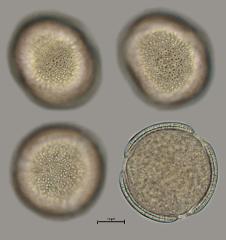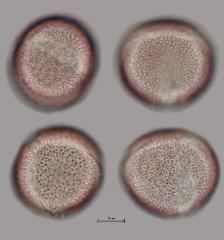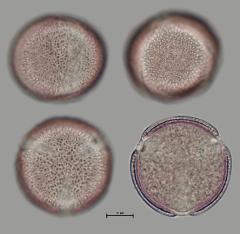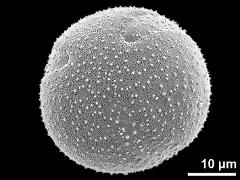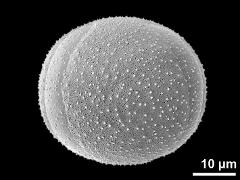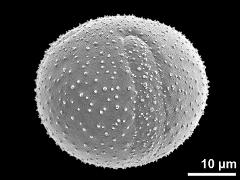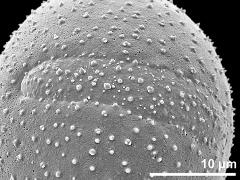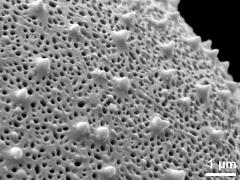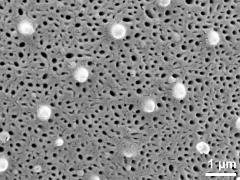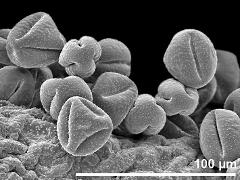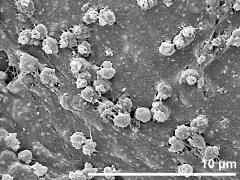Pulsatilla oenipontana
Taxonomy: Angiospermae, Ranunculales, Ranunculaceae, Pulsatilla
Links: http://flora.nhm-wien.ac.at/Seiten-Arten/Pulsatilla-oenipontana.htm
Published: 2021-03-08
Pollen Description
Shape, Size and Aperture
pollen unit: monad, dispersal unit and peculiarities: monad, size (pollen unit): medium-sized (26-50 µm), size of hydrated pollen (LM): 36-40 µm, 41-50 µm, shortest polar axis in equatorial view (LM): 31-35 µm, longest polar axis in equatorial view (LM): 36-40 µm, shortest diameter in equatorial or polar view (LM): 36-40 µm, longest diameter in equatorial or polar view (LM): 36-40 µm, pollen class: colpate, polarity: isopolar, P/E-ratio: -, shape: spheroidal, outline in polar view: circular, dominant orientation (LM): oblique, P/E-ratio (dry pollen): prolate, shape (dry pollen): -, outline in polar view (dry pollen): lobate, infoldings (dry pollen): aperture(s) sunken, aperture number: 3, aperture type: colpus, aperture condition: colpate, tricolpate, aperture peculiarities: aperture membrane ornamented
Ornamentation and Structure
LM ornamentation LM: scabrate, gemmate, verrucate, nexine: -, sexine: -, SEM ornamentation SEM: microechinate, perforate, suprasculpture SEM: -, TEM tectum: -, infratectum: -, foot layer: -, endexine: -, intine: -, wall peculiarities: -, supratectal element: -
Miscellaneous
pollen coatings: -, reserves in cytoplasm: -, cell number: -, Ubisch bodies: present
Annotations: pollen grains with deviating number and distribution of apertures occur frequently
Author(s) of diagnosis: Halbritter, Heidemarie; Auer, Waltraud
Pictures
Picture legend
- hydrated pollen - fresh, glycerine, unstained, photographer: Auer, W.
- hydrated pollen - fresh, glycerine, ruthenium red, photographer: Auer, W.
- hydrated pollen - fresh, glycerine, ruthenium red, photographer: Auer, W.
- polar view - fresh, rehydration (water) & DMP & critical point dried, photographer: Halbritter, H.
- equatorial view - fresh, rehydration (water) & DMP & critical point dried, photographer: Halbritter, H.
- equatorial view - fresh, rehydration (water) & DMP & critical point dried, photographer: Halbritter, H.
- aperture - fresh, rehydration (water) & DMP & critical point dried, photographer: Halbritter, H.
- exine surface - fresh, rehydration (water) & DMP & critical point dried, photographer: Halbritter, H.
- polar area - fresh, rehydration (water) & DMP & critical point dried, photographer: Halbritter, H.
- dry pollen grains - dry, photographer: Halbritter, H.
- Ubisch bodies on inner anther wall - fresh, rehydration (water) & DMP & critical point dried, photographer: Halbritter, H.
Literature
- (1998) Pollenmorphologie der Ranunculanae. Diplomarbeit. Universität Wien : 125 pp
- (1998) Preparing living pollen material for scanning electron microscopy using 2,2-dimethoxypropane (DMP) and criticalpoint drying. Biotechnic Histochem 73: 137–143
Copyright and Citation
Cite this publication as:
Halbritter H., Auer W. 2021. Pulsatilla oenipontana. In: PalDat - A palynological database. https://www.paldat.org/pub/Pulsatilla_oenipontana/305580; accessed 2024-10-31

